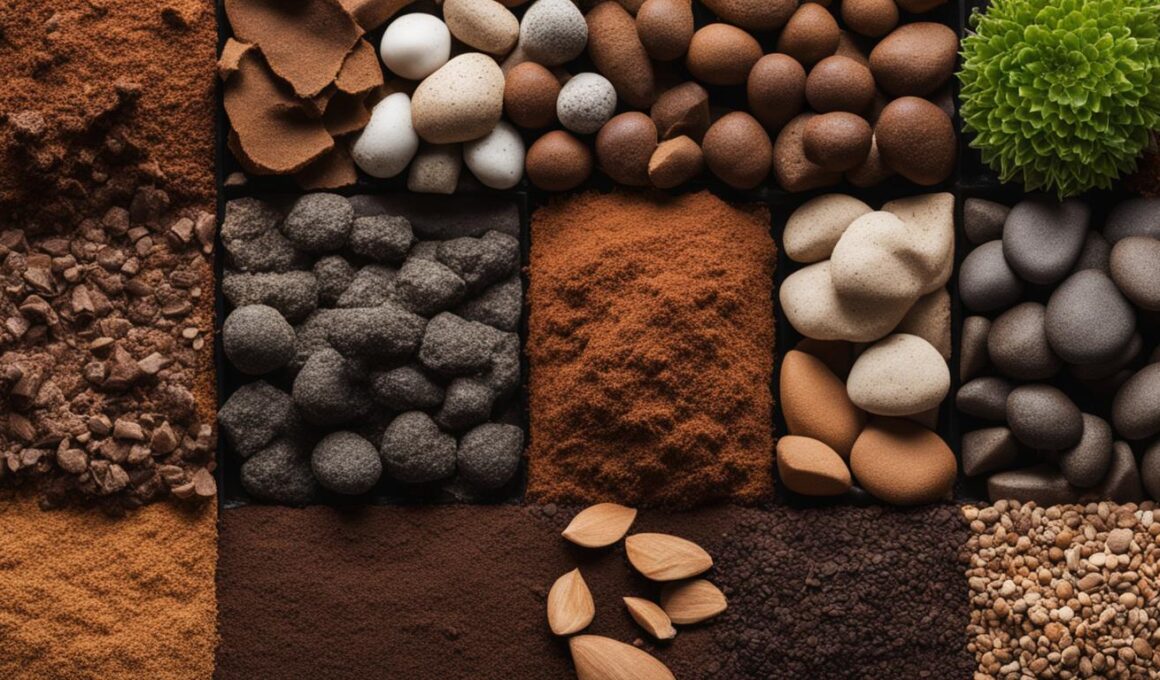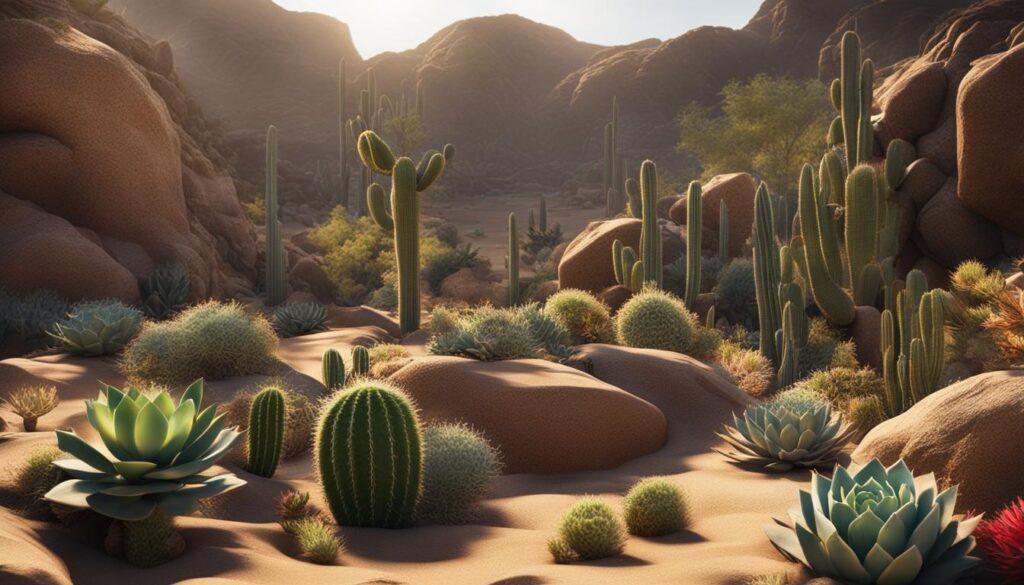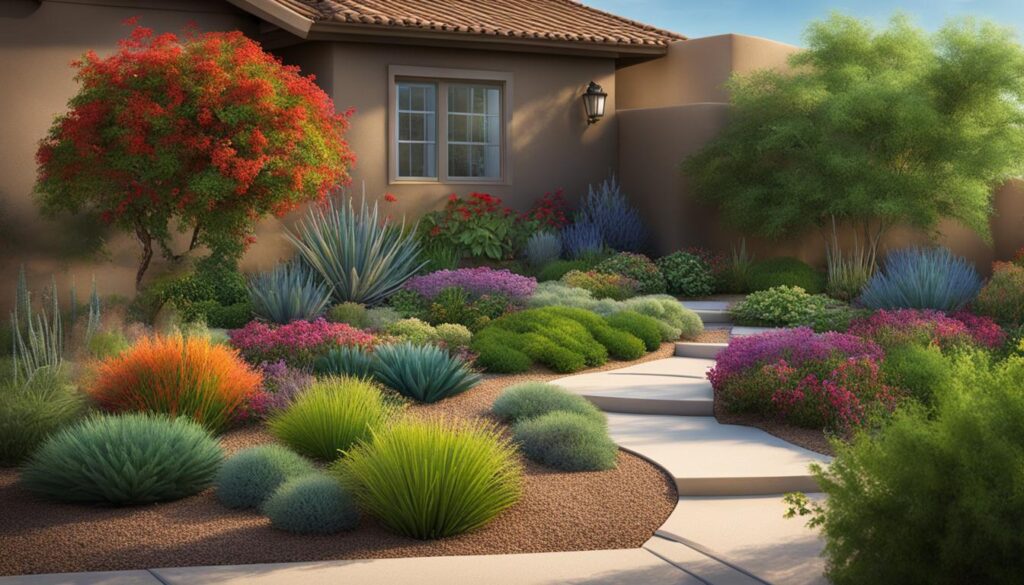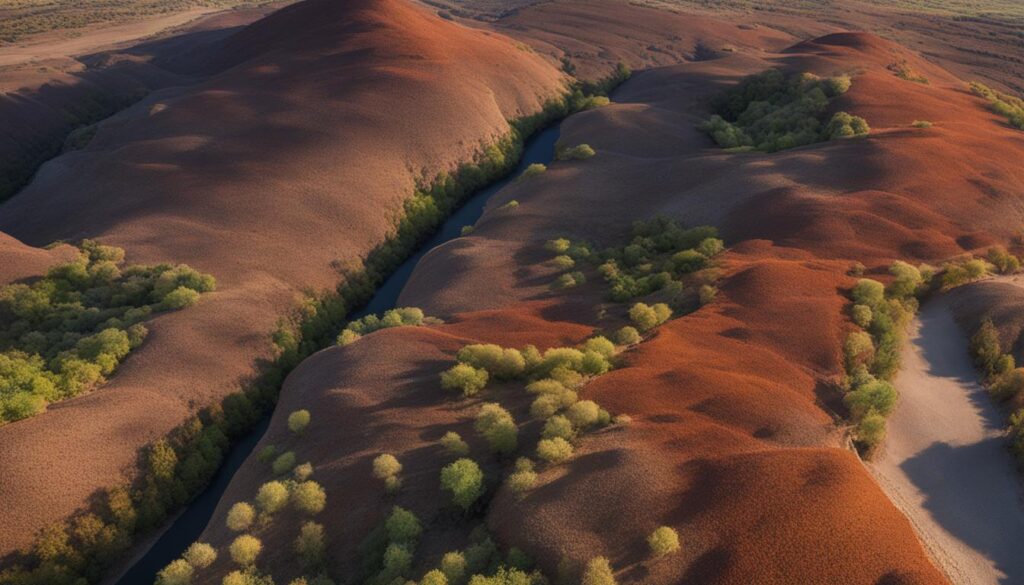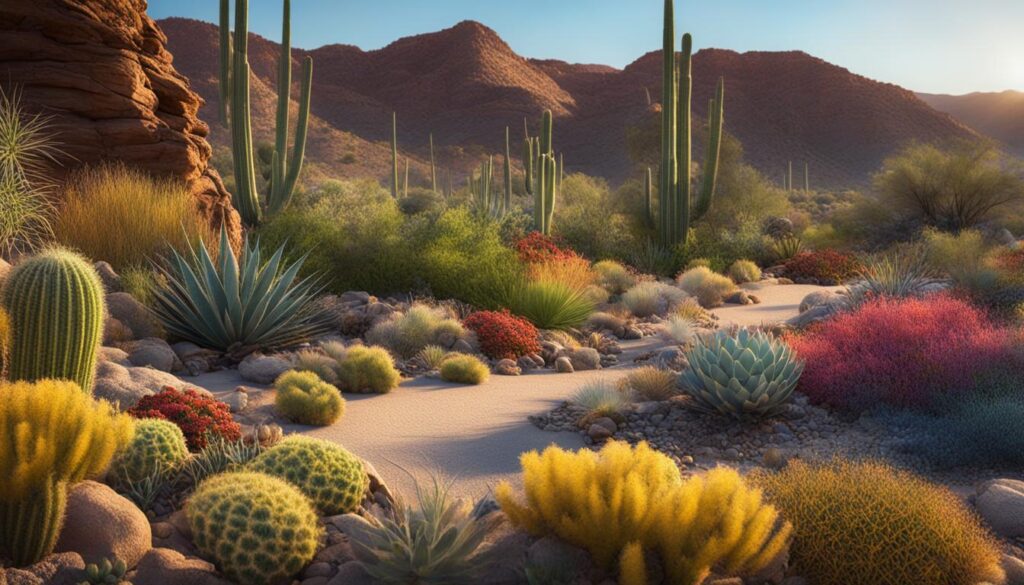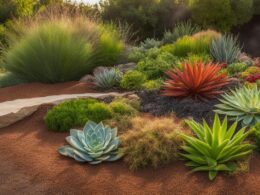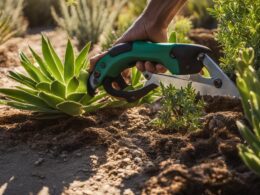Xeriscaping is a landscaping strategy that focuses on water conservation and the use of drought-tolerant plants. The right soil plays a crucial role in the success of a xeriscape garden. By choosing the best soil types for xeriscaping, you can optimize your garden for water conservation and create a sustainable and beautiful landscape.
Key Takeaways:
- Choosing the right soil types is essential for successful xeriscaping.
- Xeriscaping promotes water conservation and the use of drought-tolerant plants.
- The best soil types for xeriscaping help optimize garden for water conservation and garden optimization.
- Xeriscaping creates a sustainable and beautiful landscape.
- By selecting the best soil types, you contribute to water conservation efforts and environmental responsibility.
What is Xeriscaping and Why is it Important?
Xeriscaping is a landscaping method that minimizes water usage and promotes the use of drought-resistant plants. It is important because it helps conserve water, reduces maintenance needs, and provides a more sustainable and cost-effective landscaping solution. With the increasing awareness of climate change and the need for water conservation, xeriscaping has become a popular choice for homeowners and landscape architects.
Xeriscaping focuses on creating landscapes that require minimal water input, making it an ideal solution for arid regions and areas facing water scarcity. By implementing xeriscaping principles, you can significantly reduce water consumption while still enjoying a beautiful and vibrant garden.
This landscaping approach also contributes to a more sustainable environment. By using drought-resistant plants, xeriscaping reduces the need for chemical fertilizers and pesticides, promoting healthier ecosystems. Additionally, the reduced water usage and lower maintenance needs result in financial savings for homeowners.
Benefits of Xeriscaping:
- Conserves water and reduces water consumption by up to 70-80% compared to traditional lawns and gardens
- Reduces maintenance requirements, saving time and effort
- Creates a habitat for wildlife and important pollinators, contributing to biodiversity
- Results in financial savings for homeowners
- Promotes a more sustainable and environmentally responsible approach to landscaping
Xeriscaping is not only a practical approach to landscaping but also a responsible choice in the face of climate change and water scarcity. By adopting xeriscaping techniques and utilizing drought-resistant plants, you can create a beautiful and sustainable garden while conserving precious water resources.
The Benefits of Xeriscaping
Xeriscaping offers numerous benefits that make it an attractive option for homeowners looking to create a sustainable and low-maintenance landscape. By understanding the advantages of xeriscaping, you can make an informed decision about implementing this water-efficient gardening technique.
Water Conservation
One of the primary benefits of xeriscaping is its ability to conserve water. Compared to traditional lawns and gardens, xeriscaped landscapes can reduce water consumption by up to 70-80%. This significant reduction in water usage not only helps to preserve this valuable resource but also contributes to lower water bills for homeowners.
Low Maintenance Landscaping
Xeriscaping requires less maintenance compared to traditional landscaping methods. By selecting drought-tolerant plants that are well-adapted to your region’s climate, you can eliminate the need for excessive watering, mowing, and fertilizing. This not only saves you time and effort but also reduces the use of chemicals and promotes a healthier environment.
Financial Savings
Implementing xeriscaping techniques can lead to financial savings in multiple ways. As mentioned earlier, reduced water consumption translates to lower water bills. Additionally, the low maintenance requirements of xeriscaped gardens result in fewer expenses for lawn care services, fertilizers, and pesticides. Over time, these cost savings can add up and contribute to greater financial stability for homeowners.
Wildlife Habitat
Xeriscaped gardens create a habitat for various wildlife species, including birds, bees, butterflies, and beneficial insects. By incorporating native plants and providing food, shelter, and water sources, xeriscapes contribute to the preservation of biodiversity and help support the local ecosystem. This aspect of xeriscaping enhances the natural beauty of your landscape and promotes a healthier environment for both native and migratory wildlife.
Evaluating Your Landscape for Xeriscaping
Before starting your xeriscaping project, it is important to evaluate your landscape to ensure its suitability for this water-efficient landscaping method. Here are a few key factors to consider:
1. Sunlight and Shade
Observe the different areas of your landscape throughout the day to determine the amount of sunlight and shade they receive. This information will help you select the right plants that thrive in specific light conditions. Some plants require full sun, while others prefer partial shade or full shade.
2. Soil Type
Understand the type of soil in your garden as it plays a crucial role in the success of your xeriscape. Different plants have specific soil requirements, and knowing your soil type will help you choose the most suitable drought-tolerant plants. Common soil types include sandy, clay, loamy, and rocky, each with its own drainage and nutrient-holding capacity.
3. Existing Plant Species
Take inventory of the plants already present in your landscape. Determine which of these plants are drought-tolerant and can thrive in a water-efficient garden. Consider keeping these existing plants in your xeriscape design to maintain continuity and minimize the need for additional watering and maintenance.
4. Xeriscape Design
Think about the overall design and layout of your xeriscape. Consider factors such as the placement of pathways, seating areas, and focal points. Plan how you will group plants with similar water needs together to optimize water usage and create a visually appealing landscape.
By evaluating these aspects of your landscape, you can make informed decisions about plant selection, irrigation methods, and design elements to create a successful and sustainable xeriscape garden.
| Aspect | Considerations |
|---|---|
| Sunlight and Shade | Observe different areas of your landscape throughout the day to determine the amount of sunlight and shade they receive. |
| Soil Type | Understand the type of soil in your garden, such as sandy, clay, loamy, or rocky, as it affects drainage and nutrient-holding capacity. |
| Existing Plant Species | Take inventory of drought-tolerant plants already present in your landscape and consider incorporating them into your xeriscape design. |
| Xeriscape Design | Plan the layout and grouping of plants with similar water needs, as well as other design elements like pathways and focal points. |
Choosing the Right Plants for Xeriscaping
When it comes to xeriscaping, selecting the right plants is crucial for creating a successful and sustainable landscape. Native plants and drought-resistant species are excellent choices that thrive in dry conditions and require minimal watering. By incorporating these water-efficient plants into your xeriscape garden, you can conserve water and reduce maintenance needs.
Native plants are particularly well-suited for xeriscaping as they are naturally adapted to the local climate and soil conditions. They have developed mechanisms to survive with less water, making them ideal for water-wise landscaping. Research the native plants in your region to find species that not only conserve water but also provide a beautiful aesthetic appeal to your xeriscape.
Drought-resistant plants are another excellent option for xeriscaping. These plants are specifically bred to withstand dry conditions and require minimal irrigation. They have evolved to store water in their leaves, stems, or roots, enabling them to survive and thrive in arid environments. Consider incorporating popular drought-resistant plants such as lavender, ornamental grasses, succulents, and cacti into your xeriscape design.
Table: Recommended Water-Efficient Plants for Xeriscaping
| Plant | Description |
|---|---|
| Lavender | Aromatic, flowering shrub with gray-green foliage. Requires well-drained soil and full sun exposure. |
| Ornamental Grasses | Graceful, low-maintenance plants with a variety of colors and textures. Thrive in sunny, well-drained locations. |
| Succulents | Diverse group of plants with fleshy, water-storing leaves. Ideal for rock gardens, containers, and dry landscapes. |
| Cacti | Distinctive plants with spines and unique shapes. Highly adapted to arid conditions and require little water. |
By choosing native plants and drought-resistant species, you not only conserve water but also create a xeriscape garden that is visually appealing and environmentally responsible. These water-efficient plants are well-suited for xeriscaping and can thrive even in the most challenging environmental conditions. Embrace the beauty of nature while optimizing your landscape for water conservation with the right plant selection.
Soil Improvement for Xeriscaping
When it comes to xeriscaping, soil improvement plays a vital role in creating a successful and thriving garden. The right soil structure, fertility, and organic matter content are essential for water retention and the overall health of your plants. By implementing proper soil improvement techniques and incorporating mulch, you can optimize your xeriscape garden for water conservation and plant resilience.
One of the key factors in soil improvement is enhancing its structure. Xeriscaping gardens require well-draining soil to prevent waterlogging and root rot. To achieve this, consider adding organic matter such as compost or aged manure. These additions improve soil structure by increasing its ability to hold water while allowing excess moisture to drain away.
Another important aspect of soil improvement is enhancing its fertility. Xeriscape plants rely on nutrient-rich soil to thrive in low-water conditions. Test your soil’s nutrient levels and adjust them as necessary by adding organic amendments like compost or organic fertilizers. This will provide the necessary nutrients for your plants while reducing the reliance on synthetic fertilizers, promoting sustainability in your garden.
In addition to soil structure and fertility, incorporating mulch is crucial for xeriscaping. Mulch acts as a protective barrier, reducing evaporation and maintaining soil moisture. It also helps suppress weed growth, regulates soil temperature, and enhances the overall aesthetics of your garden. Consider using organic mulch materials like wood chips, straw, or bark that not only conserve water but also break down over time, improving soil fertility.
By focusing on soil improvement techniques such as enhancing soil structure, fertility, and incorporating mulch, you can create a xeriscape garden that thrives in low-water conditions and promotes sustainable gardening practices.
Table: Soil Improvement Techniques for Xeriscaping
| Technique | Description |
|---|---|
| Adding Organic Matter | Incorporate compost or aged manure into the soil to improve its structure and water-holding capacity. |
| Testing Soil Nutrients | Check soil nutrient levels and adjust them by adding organic amendments like compost or organic fertilizers. |
| Applying Mulch | Spread organic mulch materials like wood chips, straw, or bark to conserve moisture, suppress weeds, and regulate soil temperature. |
Efficient Irrigation Methods for Xeriscaping
Efficient irrigation is crucial for the success of a xeriscape garden. By using the right irrigation methods, you can minimize water waste and ensure that your plants receive the necessary moisture for healthy growth. Here are some efficient irrigation techniques to consider:
Drip Irrigation
Drip irrigation is a highly efficient method that delivers water directly to the roots of your plants. This system consists of a network of tubes with small holes or emitters that release water slowly and evenly. By targeting the root zone, drip irrigation minimizes evaporation and reduces water waste. It also helps prevent diseases caused by wet foliage, as the leaves remain dry. Drip irrigation is ideal for xeriscapes as it promotes water conservation and supports the growth of drought-tolerant plants.
Soaker Hoses
Soaker hoses are another effective irrigation option for xeriscaping. These porous hoses release water gradually along their entire length, allowing for deep root watering. You can place the soaker hoses around the base of your plants and cover them with mulch to maximize water absorption. Soaker hoses are cost-effective and easy to install, making them a popular choice for water-conscious gardeners.
Smart Controllers
Smart controllers, also known as weather-based controllers or ET (evapotranspiration) controllers, are technologically advanced devices that adjust irrigation schedules based on weather conditions and real-time data. These controllers use information such as temperature, humidity, rainfall, and evaporation rates to calculate the precise amount of water needed by your plants. By using smart controllers, you can avoid overwatering and reduce water waste, resulting in healthier plants and higher water savings.
By implementing efficient irrigation methods such as drip irrigation, soaker hoses, and smart controllers, you can ensure that your xeriscape garden receives the right amount of water while minimizing water waste. These techniques not only promote water conservation but also contribute to the overall sustainability of your landscape.
Xeriscaping Design Ideas
When it comes to xeriscaping, there is a wide range of design ideas to choose from. Contrary to popular belief, xeriscaping doesn’t have to resemble a southwestern desert scene. In fact, there are various options available that can add aesthetic appeal and color to any theme or style.
One design idea for xeriscaping is to incorporate Mediterranean species. Plants from regions like Africa and Australia can thrive in drought conditions and provide a unique and exotic look to your landscape. Consider including plants such as lavender, rosemary, and olive trees to create a Mediterranean-inspired oasis.
Another approach is to explore drought-resistant alternatives to water-loving trees and shrubs. Instead of using traditional water-intensive plants, opt for species that are better suited to dry conditions. This not only helps conserve water but also allows you to create a visually striking landscape that can withstand drought and require minimal maintenance.
Creating a Water-Wise Landscape
When designing your xeriscape, it’s important to keep in mind the principles of water-wise landscaping. Choose plants that have low water requirements and are well-adapted to your region’s climate. Group plants with similar water needs together to create efficient irrigation zones, and consider using mulch to retain moisture in the soil and prevent weed growth.
Additionally, incorporate hardscape elements such as gravel or flagstone pathways, rock gardens, or decorative boulders to add texture and interest to your xeriscape design. These elements not only enhance the overall aesthetics but also reduce the need for watering and maintenance.
| Plant | Description | Water Requirements |
|---|---|---|
| Red Yucca | A succulent with stunning red flowers that attract hummingbirds. | Low |
| Purple Sage | A shrub with aromatic foliage and purple flowers that add color to your landscape. | Low to Moderate |
| Desert Marigold | A perennial plant with bright yellow flowers that bloom throughout the summer. | Low |
| Blue Fescue | A grass-like plant with blue-gray foliage that adds texture and color to your xeriscape. | Low |
Remember, xeriscaping is about finding creative and sustainable ways to design your landscape while conserving water. By incorporating drought-resistant plants, utilizing efficient irrigation methods, and incorporating visually appealing design elements, you can create a beautiful and environmentally friendly xeriscape that will thrive even in the driest conditions.
Recommended Plants for Xeriscaping
Xeriscaping is all about creating a sustainable and water-efficient garden. Choosing the right plants is crucial for a successful xeriscape. Here are some recommended plant species that are well-suited for xeriscaping:
Sunbird Aloes
are beautiful succulent plants that thrive in dry conditions. They feature stunning red or orange flowers that attract pollinators, making them a great addition to any xeriscape garden.
Atriplex Silver Holy
is a drought-resistant shrub that adds texture and color to a xeriscape. With its silvery-gray leaves, this plant creates an eye-catching contrast in the landscape.
Dianella
is a versatile plant that thrives in both sunny and shaded areas. It features ornamental grass-like leaves and produces beautiful purple or blue berries, adding visual interest to a xeriscape garden.
Mediterranean Sage
is a drought-tolerant perennial herb with aromatic gray-green leaves and vibrant purple flowers. It not only adds beauty to a xeriscape but also attracts pollinators like butterflies and bees.
Eremophila
, also known as Emu Bush, is a hardy shrub with striking tubular flowers. It comes in various colors, including red, yellow, and pink, and adds a splash of color to a xeriscape garden.
These recommended plants for xeriscaping are just a starting point. Depending on your specific climate and personal preferences, there are many other drought-resistant species to explore. Remember to consider factors such as sunlight exposure, soil type, and water requirements when choosing plants for your xeriscape garden. By selecting the right plants, you can create a beautiful, low-maintenance, and water-efficient landscape.
Sustainable Landscaping with Xeriscaping
Implementing xeriscaping techniques in your landscape not only helps conserve water but also promotes sustainable landscaping practices and environmental responsibility. By choosing the right soil types, drought-resistant plants, and efficient irrigation methods, you can create a beautiful and eco-friendly garden that minimizes water usage and maintenance needs.
Xeriscaping is all about optimizing your garden for water conservation while still maintaining aesthetic appeal. By incorporating native plants and other water-efficient species, you can reduce your water consumption by up to 70-80% compared to traditional lawns and gardens. This not only helps lower your water bills but also contributes to the overall effort of preserving this precious resource.
In addition to water conservation, xeriscaping offers financial savings and benefits to local ecosystems. By reducing water usage and lowering maintenance needs, you can save both time and money. Xeriscaped gardens also create habitats for wildlife and important pollinators, supporting biodiversity and promoting a greener and more sustainable future.
| Benefits of Xeriscaping | Sustainable Landscaping Practices | Water Conservation | Environmental Responsibility |
|---|---|---|---|
| Reduces water consumption | Optimizes garden for resource efficiency | Minimizes water usage | Preserves water for future generations |
| Requires less maintenance | Promotes natural and eco-friendly practices | Lower water bills | Supports local ecosystems |
| Creates wildlife habitats | Reduces reliance on synthetic chemicals | Financial savings | Contributes to a greener future |
By embracing xeriscaping and incorporating its principles into your landscape, you can enjoy a beautiful, low-maintenance garden while making a positive impact on the environment. With the right soil, plants, and irrigation methods, you can create a sustainable and water-wise outdoor space that not only enhances the natural beauty of your property but also promotes a more sustainable way of living.
What Are the Recommended Soil Types for Xeriscaping?
When planning a xeriscaping project, it’s crucial to conduct xeriscape soil testing analysis to determine the best soil types for your landscaping. Generally, sandy soils, gravelly soils, and loamy soils are recommended for xeriscaping due to their excellent drainage and ability to retain moisture, essential for water-efficient landscaping.
Additional Resources for Xeriscaping
If you’re eager to learn more about xeriscaping and want access to additional resources, there are various guides and plant lists available to assist you. These resources can provide valuable information on xeriscape design, plant selection, and creative landscaping ideas. By utilizing these resources, you can effectively create the perfect xeriscape landscape and optimize your garden for water conservation.
Whether you’re a beginner or an experienced gardener, xeriscaping guides can offer step-by-step instructions and expert tips to help you navigate the process. They cover topics such as evaluating your landscape, choosing the right plants, improving your soil, and implementing efficient irrigation methods. These guides can serve as your go-to reference, ensuring that you make informed decisions throughout your xeriscaping journey.
Moreover, plant lists specific to xeriscaping can be an invaluable resource. These lists feature a variety of drought-resistant, water-efficient plants that thrive in different regions. By consulting these lists, you can easily identify and select plants that suit your climate and aesthetic preferences. With the right plants, you can create a stunning xeriscape garden that is not only visually appealing but also environmentally responsible.
Start Your Xeriscaping Journey Today
Embarking on a xeriscaping project can be exciting and rewarding. By utilizing reliable xeriscaping resources, such as guides and plant lists, you can gain the knowledge and inspiration needed to transform your landscape into a water-efficient and visually stunning oasis. Take the first step toward creating a sustainable garden and optimizing your outdoor space for water conservation. Dive into the world of xeriscaping and uncover the endless possibilities it offers.





